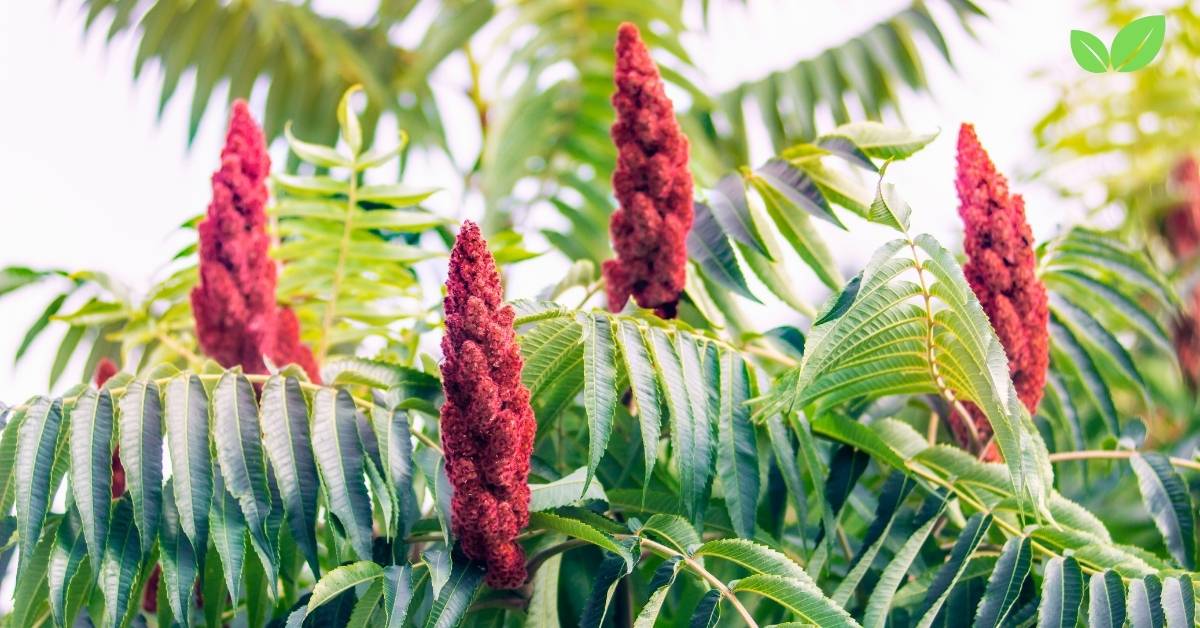Introduction
The sumac tree is a highly diverse genus of plants found across the globe, known for its vibrant fall foliage, distinctive berries, and importance to various ecosystems. Often misunderstood due to the poisonous variety of sumac, most species are not only safe but also beneficial to the environment, supporting wildlife, preventing soil erosion, and playing a crucial role in ecological restoration projects. This article delves into the environmental niche of the sumac tree, examining its species diversity, ecological roles, habitat preferences, and importance in environmental conservation.
Overview of the Sumac Tree
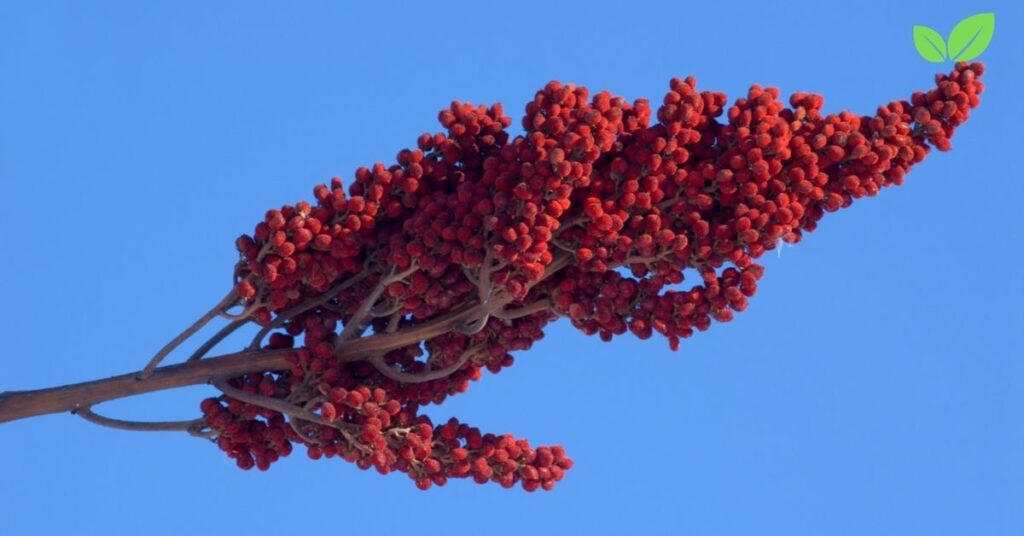
Sumac Species Diversity
Sumac refers to plants in the genus Rhus, which comprises more than 150 species found in temperate and subtropical regions. The most common sumac trees include:
- Staghorn sumac (Rhus typhina): Native to North America, known for its fuzzy branches and brilliant red fall leaves.
- Smooth sumac (Rhus glabra): A similar species to staghorn sumac, but without the fuzzy stems, also native to North America.
- Winged sumac (Rhus copallinum): Found in the eastern United States, this species has distinctive “wings” along its leaf stalks.
- Poison sumac (Toxicodendron vernix): This is the one to avoid, as it produces an irritant similar to poison ivy, causing skin rashes.
The diversity within the sumac family contributes to its adaptability and widespread occurrence in various climates and soil conditions. Many species of sumac are pioneer plants, meaning they are often the first to colonize disturbed or degraded land, helping to establish the conditions necessary for other plant species to thrive.
Distinctive Features of the Sumac Tree
Sumac trees are generally small to medium-sized, often growing between 10 and 30 feet tall, with some species appearing more shrub-like. They are known for their compound leaves, which can turn a vibrant red, orange, or yellow in the fall, providing spectacular autumn displays. Sumac trees produce clusters of small, yellowish-green flowers in the spring, followed by bright red or purple berries that persist through the winter months.
The fuzzy, velvety texture of the branches in species like the staghorn sumac is another defining feature. These branches resemble the antlers of a stag in velvet, which is how the plant earned its common name.
Ecological Role of the Sumac Tree

Habitat Restoration and Soil Stabilization
Sumac trees are pioneers in ecological restoration, particularly in areas where the land has been disturbed by construction, farming, or natural disasters. Their ability to grow quickly and thrive in poor, eroded soils makes them invaluable in efforts to restore ecosystems and prevent further degradation. One of the most significant environmental benefits of the sumac tree is its role in soil stabilization.
The extensive root systems of sumac trees help to hold soil in place, preventing erosion, especially on slopes or in areas prone to wind or water erosion. In this way, sumac helps protect the integrity of the land, making it suitable for the re-establishment of native plant species. By colonizing disturbed areas, sumac trees pave the way for other plants, eventually helping to reestablish a stable ecosystem.
Wildlife Support
Another key environmental role of the sumac tree is its support for wildlife. The berries produced by sumac trees are an important food source for various birds, mammals, and insects. During the winter months, when food is scarce, the high-energy berries of the sumac tree become a critical food source for animals like robins, bluebirds, and other songbirds. The berries can persist on the tree well into winter, offering sustenance long after other food sources have disappeared.
In addition to providing food, sumac trees also offer shelter and nesting sites for birds and small mammals. The dense foliage and low-lying branches create safe spaces for animals to hide from predators, while the flowers attract pollinators like bees and butterflies during the growing season. This makes the sumac tree an integral part of the food web in its native ecosystems.
Habitat Preferences of the Sumac Tree
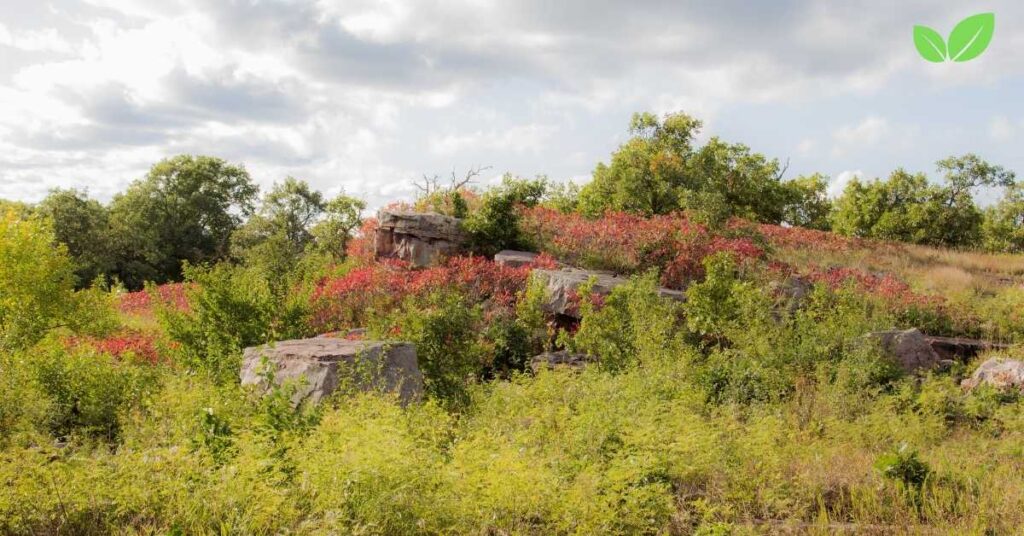
Soil and Climate Conditions
Sumac trees are highly adaptable and can thrive in a wide range of soil and climate conditions. They are commonly found in dry, well-drained soils, but some species, such as the staghorn sumac, can tolerate more moisture. Sumac is typically drought-tolerant, making it an ideal plant for regions that experience dry spells or where water conservation is a concern.
In terms of climate, sumac trees are hardy in USDA zones 3 to 9, which includes most of North America. They are especially common in open fields, along roadsides, and on the edges of forests, where they receive full sunlight. However, sumac trees can also grow in partial shade, although their growth may be slower, and their fall colors less vibrant in these conditions.
Urban and Rural Growth
One of the reasons sumac trees are so widely distributed is their ability to thrive in both urban and rural settings. In rural areas, sumac trees are often found in meadows, along streams, and at the edges of forests. In urban environments, they are commonly used in landscaping, along highways, and in parks due to their aesthetic appeal and environmental benefits.
Sumac’s tolerance for pollution and poor soil conditions makes it a popular choice for planting in cities, where other trees may struggle to grow. Its ability to quickly establish itself in disturbed areas also makes it useful for urban reforestation projects, helping to bring greenery back to areas that have been heavily developed or degraded.
The Sumac Tree in Environmental Conservation
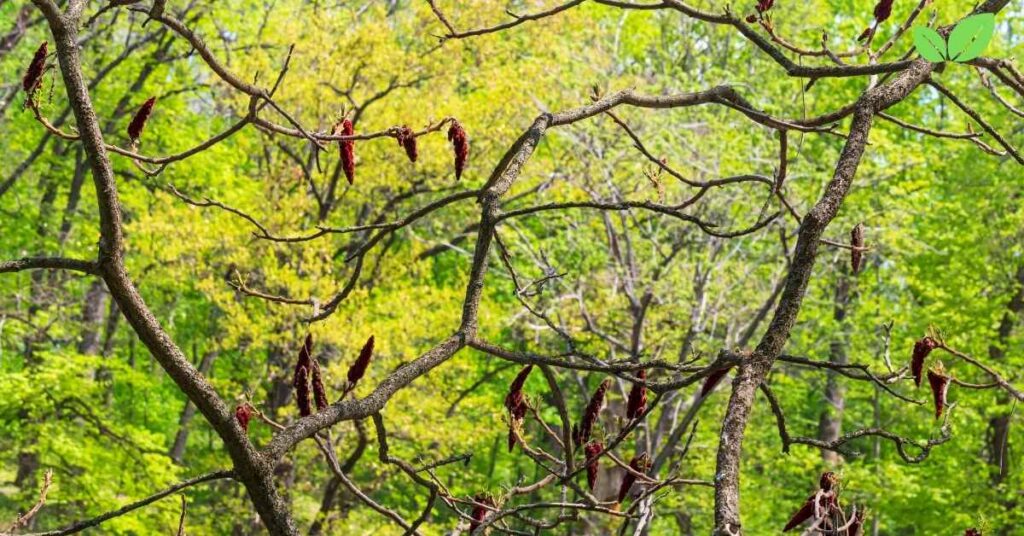
Restoration Projects
One of the most important uses of sumac trees in modern times is in ecological restoration projects. As a pioneer species, sumac is often used to rehabilitate areas that have been damaged by human activity, such as abandoned mining sites, degraded farmland, or areas affected by wildfires. Sumac’s rapid growth and soil-stabilizing properties make it an effective tool for reclaiming land and preventing further erosion.
For example, in areas affected by deforestation or overgrazing, sumac trees can be planted to help kick-start the regeneration process. Over time, sumac trees improve soil quality by adding organic matter, creating a more hospitable environment for other plant species to take root. As a result, sumac trees play a vital role in the early stages of ecological succession, helping to restore the balance of ecosystems that have been thrown off by human intervention.
Carbon Sequestration
While sumac trees are not as large as many other tree species, they still contribute to carbon sequestration, the process by which trees absorb carbon dioxide from the atmosphere and store it as biomass. By planting sumac trees, particularly in areas where other vegetation is scarce, communities can help mitigate the effects of climate change by reducing the amount of carbon dioxide in the atmosphere.
Although their carbon sequestration potential is lower than that of larger trees, sumac trees still play a role in absorbing greenhouse gases and promoting a healthier atmosphere. When used in combination with other reforestation efforts, sumac trees can contribute to broader climate change mitigation strategies.
The Cultural and Historical Importance of Sumac
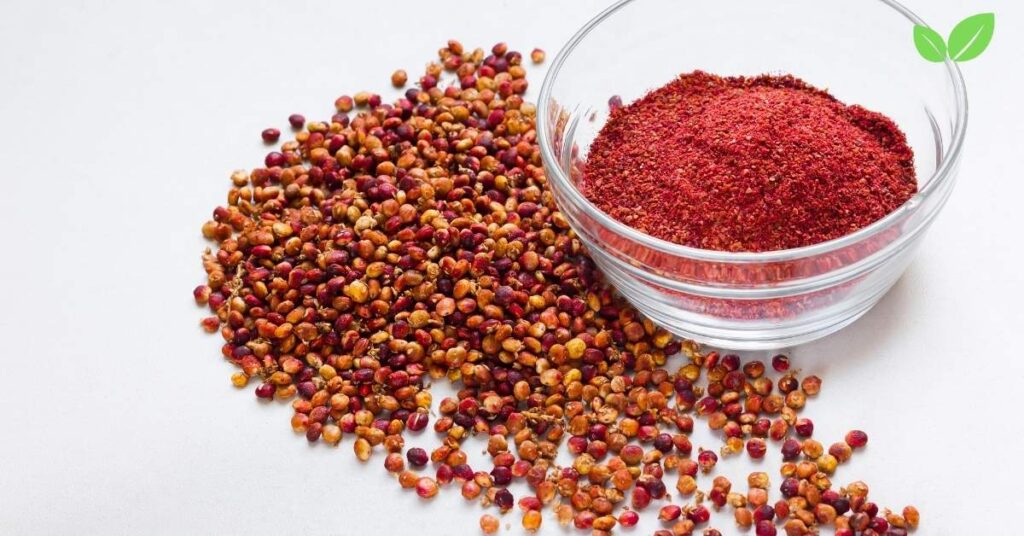
Indigenous Uses of Sumac
For thousands of years, sumac has been an important plant for Indigenous peoples in North America, who have used it for food, medicine, and dyes. The berries of certain species, such as staghorn sumac, are edible and have long been used to make a tart, lemon-flavored drink often referred to as “sumac lemonade.” Indigenous peoples also used sumac as a seasoning, and today, it remains a common ingredient in Middle Eastern cuisine, where dried and ground sumac berries add a tangy flavor to dishes.
In addition to its culinary uses, sumac was historically used as a medicinal plant. Various parts of the plant, including the bark, roots, and berries, were used to treat ailments ranging from sore throats and colds to skin conditions and digestive issues. The plant was also used to dye clothing and create vibrant, natural pigments, with the bright red berries providing a rich source of color for fabrics and art.
Sumac in Modern Landscapes
Today, sumac continues to be valued for its aesthetic and ecological benefits in both residential and commercial landscapes. Its striking fall colors, interesting branch structure, and wildlife support make it a popular choice for naturalistic and wildlife-friendly garden designs.
Sumac is also commonly used in urban landscapes, where its ability to tolerate poor soil, pollution, and drought make it an ideal candidate for challenging growing conditions. As cities and towns increasingly seek to incorporate more green spaces and native plants into their environments, sumac trees provide a low-maintenance, high-impact solution.
Environmental Challenges and Sumac Tree Management
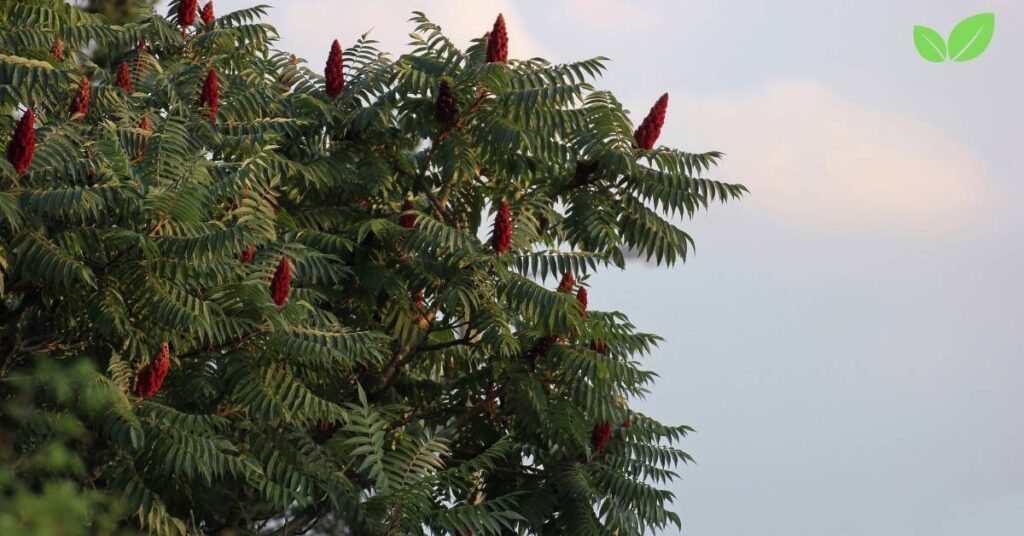
Invasiveness Concerns
While sumac trees offer numerous environmental benefits, they can sometimes become invasive, particularly when planted outside their native range. In areas where sumac species are not native, they can spread rapidly and outcompete local vegetation, leading to a reduction in biodiversity.
This is especially true for species like smooth sumac and staghorn sumac, which spread aggressively through both seeds and rhizomes (underground stems). Once established, sumac can form dense thickets that are difficult to remove, making it challenging for other plant species to gain a foothold. As a result, land managers and conservationists must carefully consider where and how sumac trees are planted to ensure they do not negatively impact native ecosystems.
Managing Sumac in Restoration Projects
Despite concerns about invasiveness, sumac trees remain an important tool in ecological restoration projects, provided they are managed properly. In areas where sumac is native, its rapid growth and ability to stabilize soil make it an invaluable asset for restoring disturbed ecosystems. However, careful planning is essential to ensure that sumac trees do not become overly dominant and crowd out other native species.
Strategies for Managing Sumac in Restoration Projects
To prevent sumac from becoming invasive in restoration projects, several strategies can be employed:
- Selective Planting: Plant sumac trees in areas where their growth can be contained, such as along slopes, roadsides, or in disturbed areas where competition from other plant species is low.
- Monitoring and Control: Regularly monitor areas where sumac has been planted to ensure that it is not spreading beyond the intended boundaries. If Sumac begins to dominate the area, measures such as controlled burns, mechanical removal, or targeted herbicide application may be necessary to keep its growth in check.
- Encouraging Biodiversity: To prevent Sumac from forming monocultures, restoration projects should focus on planting a diverse range of native species alongside Sumac. By promoting biodiversity, land managers can help create a balanced ecosystem where sumac plays a role without overwhelming other species.
- Integrated Management Plans: Long-term success in managing sumac in restoration efforts requires an integrated approach. This includes considering the specific environmental conditions, the needs of the local wildlife, and the long-term goals of the restoration project.
Benefits of the Sumac Tree for Pollinators and Insects
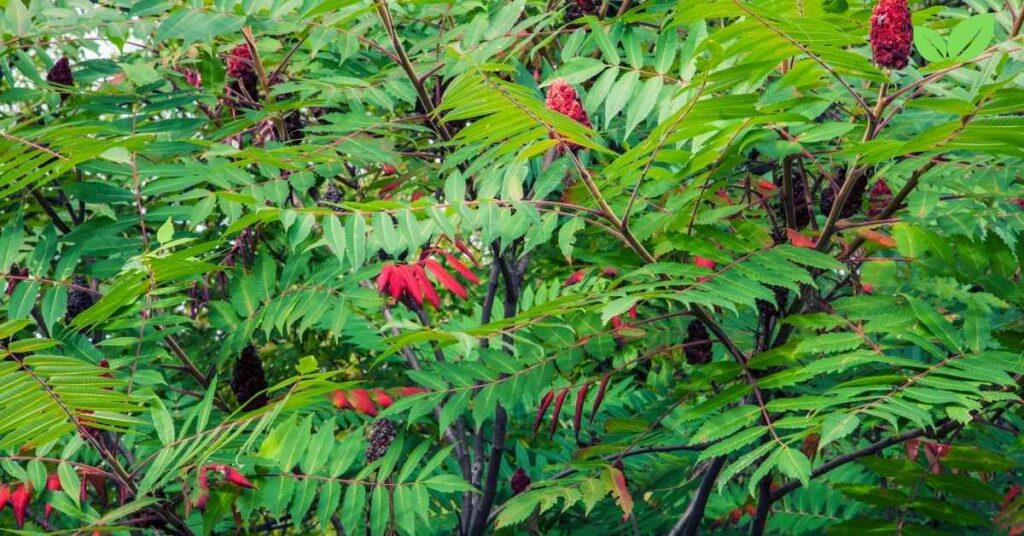
Attracting Pollinators
One of the ecological benefits of the sumac tree is its role in supporting pollinators. During the spring and summer, sumac trees produce clusters of small, greenish-yellow flowers that attract a variety of pollinators, including bees, butterflies, and beetles. While sumac flowers may not be as showy as those of other plants, they provide an important nectar source for pollinators, particularly in areas where other flowering plants may be scarce.
The flowers of sumac trees bloom at a time when pollinators are actively foraging, making them an essential part of the food web. By attracting pollinators, sumac trees contribute to the pollination of other plant species in the surrounding area, helping to maintain plant diversity and ecosystem health.
Supporting Insect Populations
In addition to attracting pollinators, sumac trees support a wide variety of insects. The dense foliage and branches of sumac provide shelter for insects, while the berries serve as a food source for certain insect species during the winter months. Insects that thrive on sumac trees include caterpillars, moths, and ants, many of which play critical roles in the ecosystem, such as decomposing organic matter or serving as food for birds and other wildlife.
Sumac trees are also known to harbor beneficial insects like predatory beetles, which help control pest populations. This makes sumac an important plant in integrated pest management strategies, particularly in organic farming and gardening practices.
The Role of Sumac in Traditional Medicine and Food

Sumac in Traditional Medicine
Throughout history, the sumac tree has been valued for its medicinal properties. Indigenous peoples in North America and other cultures around the world have used various parts of the sumac tree to treat a wide range of ailments. The berries, leaves, bark, and roots of certain sumac species have been used to make teas, poultices, and decoctions for medicinal purposes.
Some of the traditional uses of sumac in medicine include:
- Anti-inflammatory properties: Sumac has been used to treat inflammatory conditions such as arthritis, sore throats, and skin irritations. The tannins present in the plant have astringent properties, which can help reduce swelling and inflammation.
- Digestive aid: Sumac has been used as a remedy for indigestion and gastrointestinal issues. The plant’s mild acidity and tannins may help soothe the digestive tract and promote healthy digestion.
- Antimicrobial uses: Sumac has demonstrated antimicrobial properties, making it useful for treating infections, wounds, and other conditions where bacterial or fungal growth is a concern.
While sumac continues to be used in traditional medicine, modern science has also begun to explore its potential health benefits. Recent studies have investigated sumac’s antioxidant and antimicrobial properties, confirming its potential as a natural remedy for various conditions.
Sumac as a Culinary Ingredient
Beyond its medicinal uses, sumac has long been used as a culinary ingredient, particularly in Middle Eastern and Mediterranean cuisines. The dried and ground berries of edible sumac species, such as Rhus coriaria, are used as a spice to add a tangy, lemon-like flavor to food. Sumac is a key ingredient in traditional spice blends like za’atar, and it is often used to season meats, vegetables, and salads.
In North America, sumac berries have traditionally been used to make a tart, refreshing beverage known as “sumac lemonade.” This drink is made by steeping the berries in cold water, which extracts the natural acidity and creates a thirst-quenching infusion. The culinary uses of sumac highlight its versatility as both a food source and a flavoring agent.
Challenges in Sumac Tree Conservation
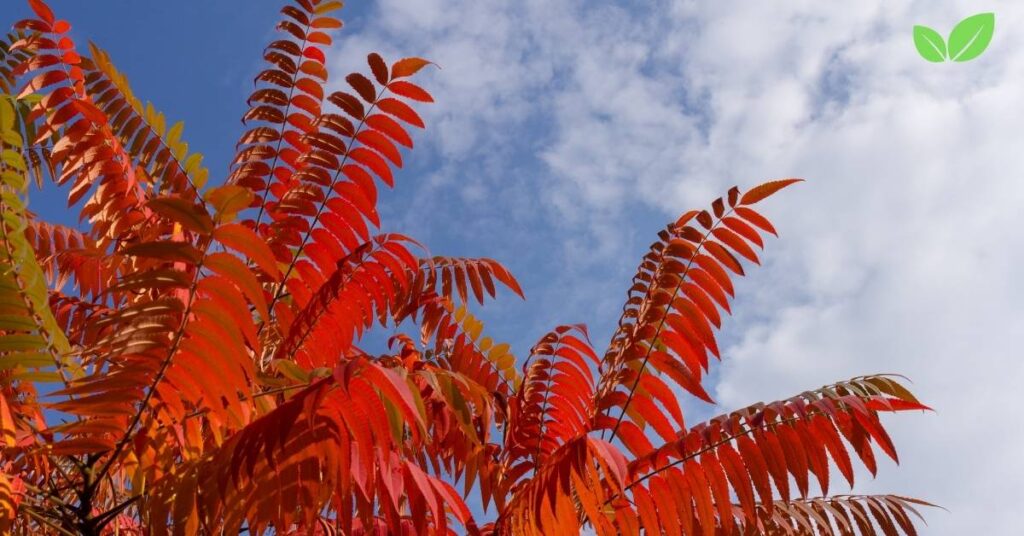
Threats to Native Sumac Populations
While sumac trees are generally hardy and adaptable, they are not immune to the challenges posed by habitat loss, climate change, and invasive species. In areas where native sumac populations thrive, changes in land use, such as urban development, agriculture, and deforestation, can threaten their habitats. Additionally, the introduction of invasive plant species can outcompete sumac trees, reducing their numbers and diminishing their role in local ecosystems.
Climate Change Impacts
Climate change poses a significant challenge to sumac trees, particularly in regions where shifting temperatures and precipitation patterns are altering the growing conditions that sumac trees rely on. Droughts, heatwaves, and changes in seasonal weather patterns can all impact the health and survival of sumac trees, especially in areas where water resources are already scarce.
Moreover, changes in climate can affect the reproductive cycles of sumac trees, potentially reducing their ability to produce flowers and berries, which in turn impacts the wildlife that depends on them for food and shelter.
Conservation Efforts
Conservationists are working to protect native sumac populations by preserving their habitats and promoting the use of sumac in reforestation and ecological restoration projects. Efforts to raise awareness about the ecological importance of sumac trees have led to increased planting in urban and rural areas, as well as initiatives to protect the trees from overharvesting and habitat destruction.
In some regions, sumac trees are being used in efforts to combat desertification, where their ability to stabilize soil and retain moisture can help restore degraded landscapes. These conservation efforts are essential to ensuring that sumac trees continue to play their vital role in supporting biodiversity and ecosystem health.
Conclusion
The sumac tree is a remarkable plant with a broad environmental niche, contributing to ecosystems through its roles in soil stabilization, wildlife support, and habitat restoration. From its use in traditional medicine to its value as a food source and pollinator attractor, the sumac tree has long been an important part of human history and ecological health.
As the world faces increasing environmental challenges, such as climate change and habitat degradation, the adaptability and ecological contributions of sumac trees make them valuable allies in the efforts to restore and protect our natural landscapes. By understanding the environmental niche of the sumac tree and supporting conservation efforts, we can help preserve this vital species for future generations to enjoy.
Read More: Dwarf Dogwood Tree: Exploring Its Environmental Niche, Ecological Role, and Conservation

